
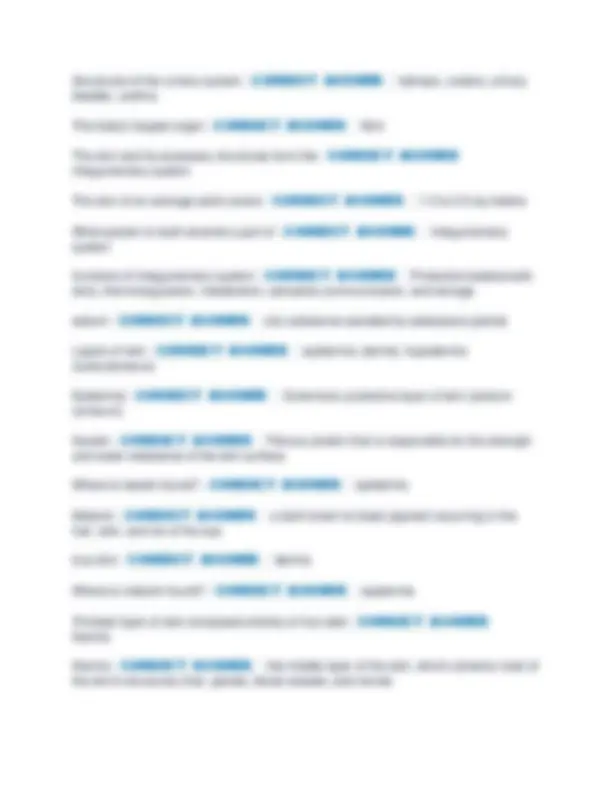
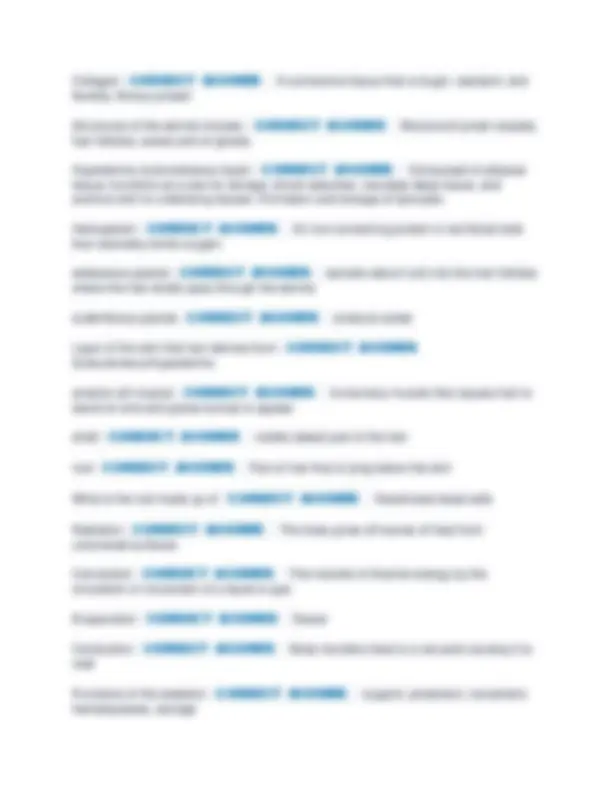
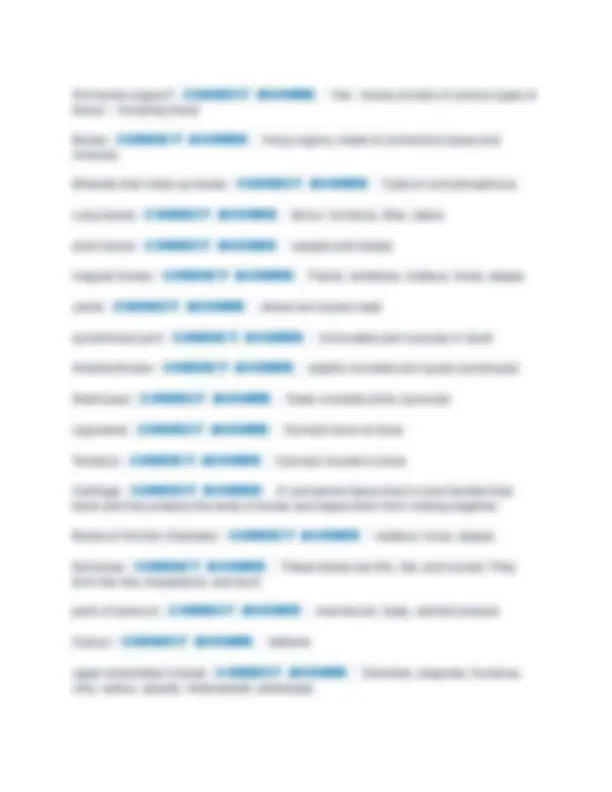
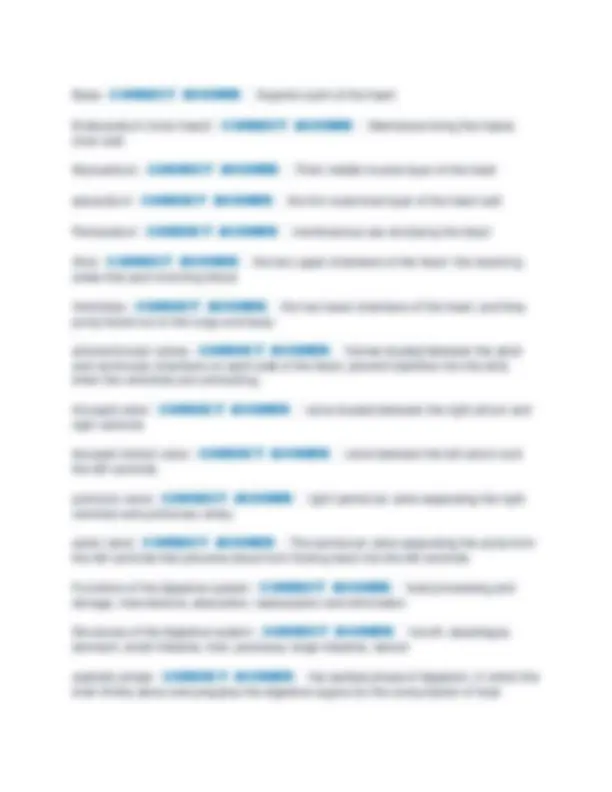
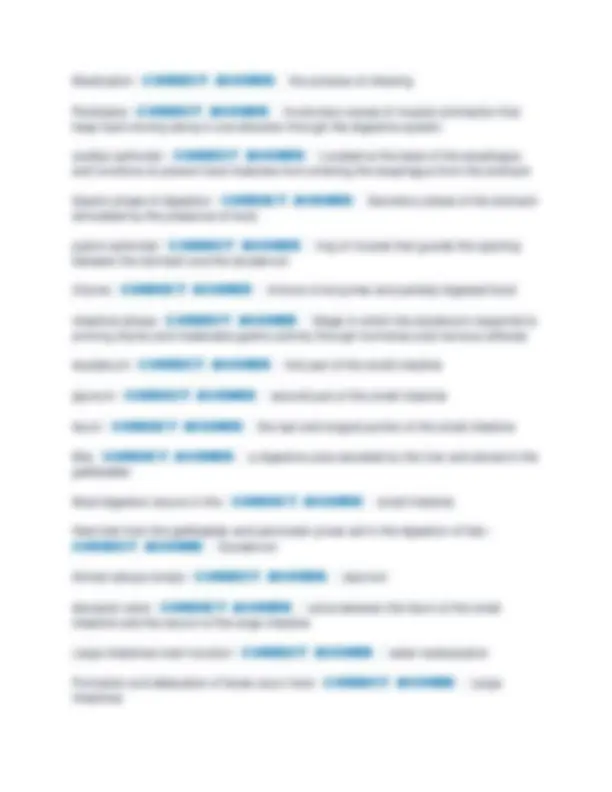
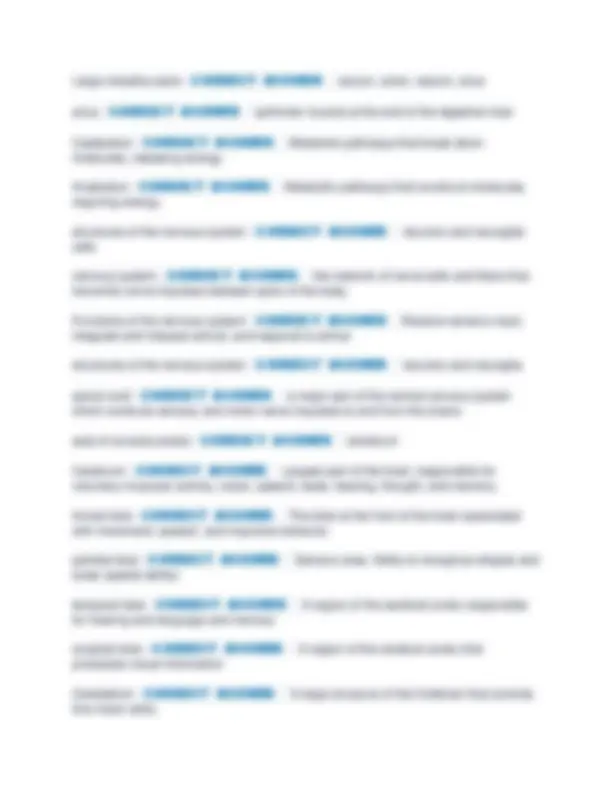


Study with the several resources on Docsity

Earn points by helping other students or get them with a premium plan


Prepare for your exams
Study with the several resources on Docsity

Earn points to download
Earn points by helping other students or get them with a premium plan
Community
Ask the community for help and clear up your study doubts
Discover the best universities in your country according to Docsity users
Free resources
Download our free guides on studying techniques, anxiety management strategies, and thesis advice from Docsity tutors
IBAM Module 1 ACTUAL EXAM] LATEST VERSION [ QUESTIONS AND ANSWERS] WITH STUDY GUIDE DETAILED AND VERIFIED FOR GUARANTEED PASS- LATEST UPDATE 2025 GRADED A
Typology: Exams
1 / 12

This page cannot be seen from the preview
Don't miss anything!







Transverse plane - CORRECT ANSWER Divides the body into superior and inferior Dorsal cavity is divided into two sub-cavities - CORRECT ANSWER Cranial cavity & spinal cavity Medial - CORRECT ANSWER Towards the midline Ventral cavity is divided into two sub-cavities - CORRECT ANSWER Thoracic cavity & abdominal cavity Lateral - CORRECT ANSWER away from the midline Proximal - CORRECT ANSWER Closer to the point of attachment Distal - CORRECT ANSWER farther from the point of attachment Levels of organization - CORRECT ANSWER cell, tissue, organ, organ system, organism types of human body tissues - CORRECT ANSWER Muscle Tissues, Nervous Tissues, Connective Tissue, Epithelial Tissue (CEMN); similar type cells that perform the same function (e.g. all muscle tissue contracts); four types of tissue - nerve, muscle, epithelial, connective types of muscle tissue - CORRECT ANSWER Cardiac, skeletal, smooth Tissues - CORRECT ANSWER Groups of cells that are similar in structure and function nervous tissue function & locations - CORRECT ANSWER internal communication- found in brain, spinal cord, and nerves muscle tissue function & location - CORRECT ANSWER Contracts to cause movement
epithelial tissue functions & functions - CORRECT ANSWER protection, absorption, filtration, excretion, secretion, sensory reception. Found in lining of GI tract & hollow organs & on surface of skin (epidermis) connective tissue functions - CORRECT ANSWER binds body tissues together, supports the body, provides protection. Found in bones, tendons, and other soft padding tissue urinary system - CORRECT ANSWER Maintains homeostasis - by controlling water/blood volume,maintains pH,reabsorbs electrolytes, activates vitamin D for bone calcification. Manufacture- secretes renin & erythropoietin Processing of waste- filters blood, forms urine (kidneys), stores urine(bladder) Elimination - rids protein wastes, excess salts, and toxic materials Structures of the urinary system - CORRECT ANSWER kidneys, ureters, urinary bladder, urethra Kidneys - CORRECT ANSWER two bean-shaped organs located on each side of the vertebral column on the posterior wall of the abdominal cavity. The size of a human fist. Right kidney is slightly lower than left bc of liver Nephron Cells - CORRECT ANSWER Cells found in the liver that form urine Renin - CORRECT ANSWER hormone secreted by the kidney that raises blood pressure Erythropoietin - CORRECT ANSWER A hormone produced and released by the kidney that stimulates the production of red blood cells by the bone marrow. functions of the urinary system - CORRECT ANSWER excretes waste products from the blood, controls water balance by regulating volume of urine produced, stores urine prior to voluntary elimination, regulates blood ion concentrations and pH Kidneys receive blood from - CORRECT ANSWER renal arteries abdominal aorta - CORRECT ANSWER lower descending aorta, takes blood to lower trunk and legs Renal arteries branch directly from - CORRECT ANSWER abdominal aorta renal vein - CORRECT ANSWER empties into inferior vena cava to return blood to heart after filtration of blood
Collagen - CORRECT ANSWER A connective tissue that is tough, resistant, and flexible, fibrous protein Structures of the dermis include: - CORRECT ANSWER Blood and lymph vessels, hair follicles, sweat and oil glands Hypodermis (subcutaneous layer) - CORRECT ANSWER Composed of adipose tissue; functions as a site for storage, shock absorber, insulates deep tissue, and anchors skin to underlying tissues. Formation and storage of lipocytes Hemoglobin - CORRECT ANSWER An iron-containing protein in red blood cells that reversibly binds oxygen. sebaceous glands - CORRECT ANSWER secrete sebum (oil) into the hair follicles where the hair shafts pass through the dermis suderiferous glands - CORRECT ANSWER produce sweat Layer of the skin that hair derives from - CORRECT ANSWER Subcutaneous/hypodermis arrector pili muscle - CORRECT ANSWER Involuntary muscle that causes hair to stand on end and goose bumps to appear shaft - CORRECT ANSWER visible (dead) part of the hair root - CORRECT ANSWER Part of hair that is lying below the skin What is the nail made up of - CORRECT ANSWER Keratinized dead cells Radiation - CORRECT ANSWER The body gives off waves of heat from uncovered surfaces Convection - CORRECT ANSWER The transfer of thermal energy by the circulation or movement of a liquid or gas Evaporation - CORRECT ANSWER Sweat Conduction - CORRECT ANSWER Body transfers heat to a ice pack causing it to melt Functions of the skeleton - CORRECT ANSWER support, protection, movement, hematopoiesis, storage
Are bones organs? - CORRECT ANSWER Yes - bones consist of various types of tissue -- Including blood Bones - CORRECT ANSWER living organs, made of connective tissue and minerals Minerals that make up bones - CORRECT ANSWER Calcium and phosphorus Long bones - CORRECT ANSWER femur, humerus, tibia, radius short bones - CORRECT ANSWER carpals and tarsals irregular bones - CORRECT ANSWER Facial, vertebrae, malleus, Incas, stapes Joints - CORRECT ANSWER where two bones meet synarthrosis joint - CORRECT ANSWER immovable joint (sutures in skull) Amphiarthrosis - CORRECT ANSWER slightly movable joint (pubic symphysis) Diathroses - CORRECT ANSWER freely movable joints (synovial) Ligaments - CORRECT ANSWER Connect bone to bone Tendons - CORRECT ANSWER Connect muscle to bone Cartilage - CORRECT ANSWER A connective tissue that is more flexible than bone and that protects the ends of bones and keeps them from rubbing together. Bones of the Ear (Ossicles) - CORRECT ANSWER malleus, incus, stapes flat bones - CORRECT ANSWER These bones are thin, flat, and curved. They form the ribs, breastbone, and skull. parts of sternum - CORRECT ANSWER manubrium, body, xiphoid process Coccyx - CORRECT ANSWER tailbone upper extremities include - CORRECT ANSWER Clavicles, scapulas, humerus, ulna, radius, carpals, metacarpals, phalanges
Functions of respiratory system - CORRECT ANSWER Oxygen-carbon dioxide exchange, acid-base balance, protection, and speech production Upper respiratory tract - CORRECT ANSWER Nose, sinuses, pharynx (NOL), larynx (voice box) Sinuses - CORRECT ANSWER Four sinuses are located on each side of the nasal area. Sinuses lighten the skull and provides resonance for the voice Pharynx - CORRECT ANSWER Air travels from the nose to the pharynx, a tube shaped passage for air and food Oropharynx - CORRECT ANSWER Throat Function of larynx cartilage - CORRECT ANSWER Keep airway open at all time Epiglottis - CORRECT ANSWER Guards the entrance to the larynx, automatically closes when swallowing lower respiratory tract - CORRECT ANSWER trachea (windpipe), bronchi, bronchiole, alveolar sacs, and lungs Ventilation - CORRECT ANSWER movement of air in and out of the lungs Inhalation/Inspiration - CORRECT ANSWER the act of taking in air as the diaphragm contracts and pulls downward. Active movement. Negative pressure exhalation/expiration - CORRECT ANSWER Breathing out or the movement of gases from the lungs to the atmosphere. Passive. Positive pressure Diaphragm - CORRECT ANSWER Large, flat muscle at the bottom of the chest cavity that helps with breathing intercostal muscles - CORRECT ANSWER Muscles located in between the ribs that contract to lift and spread the ribs during inhalation Functions of the cardiovascular system - CORRECT ANSWER Pumping blood and transportation of blood, lymph,and nutrients Layers of the heart - CORRECT ANSWER Endocardium, myocardium, epicardium, pericardium Apex - CORRECT ANSWER Inferior point of the heart
Base - CORRECT ANSWER Superior point of the heart Endocardium (inner heart) - CORRECT ANSWER Membrane lining the hearts inner wall. Myocardium - CORRECT ANSWER Thick middle muscle layer of the heart epicardium - CORRECT ANSWER the thin outermost layer of the heart wall Pericardium - CORRECT ANSWER membranous sac enclosing the heart Atria - CORRECT ANSWER the two upper chambers of the heart- the receiving areas that pool incoming blood. Ventricles - CORRECT ANSWER the two lower chambers of the heart, and they pump blood out to the lungs and body. atrioventricular valves - CORRECT ANSWER Valves located between the atrial and ventricular chambers on each side of the heart, prevent backflow into the atria when the ventricles are contracting. tricuspid valve - CORRECT ANSWER valve located between the right atrium and right ventricle bicuspid (mitral) valve - CORRECT ANSWER valve between the left atrium and the left ventricle. pulmonic valve - CORRECT ANSWER right semilunar valve separating the right ventricle and pulmonary artery aortic valve - CORRECT ANSWER The semilunar valve separating the aorta from the left ventricle that prevents blood from flowing back into the left ventricle. Functions of the digestive system - CORRECT ANSWER food processing and storage, manufacture, absorption, reabsorption and elimination Structures of the digestive system - CORRECT ANSWER mouth, esophagus, stomach, small intestine, liver, pancreas, large intestine, rectum cephalic phase - CORRECT ANSWER the earliest phase of digestion, in which the brain thinks about and prepares the digestive organs for the consumption of food
Large intestine parts - CORRECT ANSWER cecum, colon, rectum, anus anus - CORRECT ANSWER sphincter muscle at the end of the digestive tract Catabolism - CORRECT ANSWER Metabolic pathways that break down molecules, releasing energy. Anabolism - CORRECT ANSWER Metabolic pathways that construct molecules, requiring energy. structures of the nervous system - CORRECT ANSWER neurons and neuroglial cells nervous system - CORRECT ANSWER the network of nerve cells and fibers that transmits nerve impulses between parts of the body. Functions of the nervous system - CORRECT ANSWER Receive sensory input, integrate and interpret stimuli, and respond to stimuli structures of the nervous system - CORRECT ANSWER neurons and neuroglia spinal cord - CORRECT ANSWER a major part of the central nervous system which conducts sensory and motor nerve impulses to and from the brains seat of consciousness - CORRECT ANSWER cerebrum Cerebrum - CORRECT ANSWER Largest part of the brain; responsible for voluntary muscular activity, vision, speech, taste, hearing, thought, and memory. frontal lobe - CORRECT ANSWER The lobe at the front of the brain associated with movement, speech, and impulsive behavior. parietal lobe - CORRECT ANSWER Sensory area. Ability to recognize shapes and sizes (spatial ability) temporal lobe - CORRECT ANSWER A region of the cerebral cortex responsible for hearing and language and memory occipital lobe - CORRECT ANSWER A region of the cerebral cortex that processes visual information Cerebellum - CORRECT ANSWER A large structure of the hindbrain that controls fine motor skills.
special sense organs - CORRECT ANSWER eyes, ears, tongue, and nose general sense organs - CORRECT ANSWER Muscles, tendons, joints, and internal organs General sense organs detect - CORRECT ANSWER Pain, temperature, pressure, itching, and proprioception Proprioception - CORRECT ANSWER The ability to tell where one's body is in space. Structures of the sensory system - CORRECT ANSWER eyes, ears, tongue, nose, sense receptors Parts of the eye - CORRECT ANSWER cornea, pupil, optic nerve, iris, lens, retina, rod cells, cone cells Sclera - CORRECT ANSWER white of the eye. Protective outer layer that helps maintain shape Cornea - CORRECT ANSWER Refracts light as it enters the eye Iris - CORRECT ANSWER Colored part of the eye pupil - CORRECT ANSWER the adjustable opening in the center of the eye through which light enters (black part) lens - CORRECT ANSWER the transparent structure behind the pupil that changes shape to help focus images on the retina Retina - CORRECT ANSWER the light-sensitive inner surface of the eye, containing the receptor rods and cones plus layers of neurons that begin the processing of visual information Cones - CORRECT ANSWER color vision Rods - CORRECT ANSWER Retinal receptors that detect black, white, and gray external ear - CORRECT ANSWER auricle, external acoustic meatus, tympanic membrane